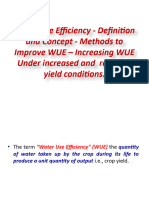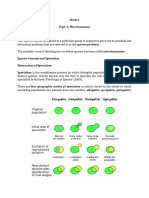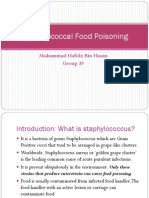100%(1)100% found this document useful (1 vote)
509 viewsSource Sink Relationship
Source Sink Relationship
Uploaded by
Bahar AliThe document discusses source-sink relationships in plants. It defines sources as parts where carbon dioxide fixation occurs, like leaves, and sinks as sites where assimilates are stored or used, like roots, flowers, and fruits. Assimilates are transported between plant parts via the phloem. Fruit production and quality depend on adequate transport of carbohydrates from source to sink tissues, as up to 60% of daily carbohydrate production can be lost through respiration if not transported to sinks.
Copyright:
© All Rights Reserved
Available Formats
Download as PPTX, PDF, TXT or read online from Scribd
Source Sink Relationship
Source Sink Relationship
Uploaded by
Bahar Ali100%(1)100% found this document useful (1 vote)
509 views8 pagesThe document discusses source-sink relationships in plants. It defines sources as parts where carbon dioxide fixation occurs, like leaves, and sinks as sites where assimilates are stored or used, like roots, flowers, and fruits. Assimilates are transported between plant parts via the phloem. Fruit production and quality depend on adequate transport of carbohydrates from source to sink tissues, as up to 60% of daily carbohydrate production can be lost through respiration if not transported to sinks.
Original Title
ppt source sink relationship
Copyright
© © All Rights Reserved
Available Formats
PPTX, PDF, TXT or read online from Scribd
Share this document
Did you find this document useful?
Is this content inappropriate?
The document discusses source-sink relationships in plants. It defines sources as parts where carbon dioxide fixation occurs, like leaves, and sinks as sites where assimilates are stored or used, like roots, flowers, and fruits. Assimilates are transported between plant parts via the phloem. Fruit production and quality depend on adequate transport of carbohydrates from source to sink tissues, as up to 60% of daily carbohydrate production can be lost through respiration if not transported to sinks.
Copyright:
© All Rights Reserved
Available Formats
Download as PPTX, PDF, TXT or read online from Scribd
Download as pptx, pdf, or txt
100%(1)100% found this document useful (1 vote)
509 views8 pagesSource Sink Relationship
Source Sink Relationship
Uploaded by
Bahar AliThe document discusses source-sink relationships in plants. It defines sources as parts where carbon dioxide fixation occurs, like leaves, and sinks as sites where assimilates are stored or used, like roots, flowers, and fruits. Assimilates are transported between plant parts via the phloem. Fruit production and quality depend on adequate transport of carbohydrates from source to sink tissues, as up to 60% of daily carbohydrate production can be lost through respiration if not transported to sinks.
Copyright:
© All Rights Reserved
Available Formats
Download as PPTX, PDF, TXT or read online from Scribd
Download as pptx, pdf, or txt
You are on page 1of 8
WHAT IS SOURCE SINK RELATIONSHIP
Functionally a plant can be divided into source and sink, sources being the parts where
net fixation of carbon dioxide occurs, and sinks being the sites where assimilates are
stored or used.
Allocation of assimilates between plant parts occurs via transport in the phloem.
(Phloem is the vascular tissue responsible for the transport of sugars from source
tissues (ex. photosynthetic leaf cells) to sink tissues (ex. non-photosynthetic root cells
or developing flowers).
Fruit production and quality depend on adequate source-sink relationships.
Carbohydrates (CH) translocated from leaves or reserve organs are the most
important for the growth and development of sink organs (mainly fruits). Up to 60% of
CH produced daily can be lost through respiration.
Xylem
The basic function
of xylem is to transport
water from roots to stems
and leaves, but it also
transports nutrients.
Click
Click icon
icon to
to add
add picture
picture
Phloem
Phloem is the vascular tissue
responsible for the transport of sugars
from source tissues (ex. photosynthetic
leaf cells) to sink tissues (ex. non-
photosynthetic root cells or developing
flowers).
You might also like
- Laboratory 1. Anatomical Position and TerminologiesDocument2 pagesLaboratory 1. Anatomical Position and TerminologiesAANo ratings yet
- Experimental DesignDocument11 pagesExperimental Designtangent12100% (1)
- AGR 351 - Water Use Efficiency - PPT 1 - Agri JunctionDocument32 pagesAGR 351 - Water Use Efficiency - PPT 1 - Agri JunctionKavinNo ratings yet
- Anatomy of GI TractDocument24 pagesAnatomy of GI TractMuhammad Ade RahmanNo ratings yet
- Age StructureDocument3 pagesAge StructureVasuNo ratings yet
- ThirstDocument30 pagesThirstvalcobacl.681.studNo ratings yet
- Eco-System: Name: Mansi Prajapati - 033 Harsh Desai - 020 Sem: 4 Year - 2 Subject: LandscapeDocument10 pagesEco-System: Name: Mansi Prajapati - 033 Harsh Desai - 020 Sem: 4 Year - 2 Subject: LandscapeHarsh DesaiNo ratings yet
- Ultra Structure of ChromosomeDocument9 pagesUltra Structure of ChromosomeJigarS.MehtaNo ratings yet
- ASSIGNMENT On Action PotentialDocument8 pagesASSIGNMENT On Action PotentialRinta Moon100% (1)
- Circulation in AnnelidaDocument2 pagesCirculation in AnnelidaNarasimha Murthy100% (1)
- Five Year Plans of IndiaDocument10 pagesFive Year Plans of IndiaJayagokul SaravananNo ratings yet
- Title, Byline, Abstract, KeywordsDocument11 pagesTitle, Byline, Abstract, KeywordsHappy WKNo ratings yet
- Ethology bookDocument20 pagesEthology bookpriyanigoyal07100% (1)
- Educational PsychologyDocument28 pagesEducational PsychologysyedmirsyedNo ratings yet
- Cerebral Venous Thrombosis PDFDocument7 pagesCerebral Venous Thrombosis PDFd dNo ratings yet
- Control of Diarrhoeal Diseases, Acute Diarrhoeal DiseasesDocument60 pagesControl of Diarrhoeal Diseases, Acute Diarrhoeal DiseasesSamarjeet KaurNo ratings yet
- Plant Taxonomy NotesDocument38 pagesPlant Taxonomy Notesopolla nianorNo ratings yet
- Avian Embryology and Fate of MesodermDocument15 pagesAvian Embryology and Fate of MesodermHINA SHAHZADI100% (1)
- Blood Transfusion CONTENTDocument7 pagesBlood Transfusion CONTENTDr-Sanjay SinghaniaNo ratings yet
- Research Ethics For LectureDocument38 pagesResearch Ethics For LectureamitksknpNo ratings yet
- Conceptual Frame Work For Structured Nursing Rounds On The Level of Patient Satisfaction and Job Satisfaction Among Nurses by Using Ludwig Von Bertalanffy General Systems TheoryDocument3 pagesConceptual Frame Work For Structured Nursing Rounds On The Level of Patient Satisfaction and Job Satisfaction Among Nurses by Using Ludwig Von Bertalanffy General Systems TheoryMalarvizhi SureshNo ratings yet
- Eco-System: by Pratyay Ganguly Lecturer, CIEM, KolkataDocument9 pagesEco-System: by Pratyay Ganguly Lecturer, CIEM, KolkataIndranilNo ratings yet
- Module-3 MicrotaxonomyDocument16 pagesModule-3 MicrotaxonomyMary Joy Annika MagtibayNo ratings yet
- 1 Anatomy of The Nervous SystemDocument41 pages1 Anatomy of The Nervous SystemFarhan HaleemNo ratings yet
- School and Society All ChapterDocument104 pagesSchool and Society All Chaptersuraasefa5No ratings yet
- Kingdom ProtistaDocument30 pagesKingdom ProtistaQueenie Salas RetesNo ratings yet
- MoultingDocument12 pagesMoultingPushpinderNo ratings yet
- CT Scan - 091026Document8 pagesCT Scan - 091026Shubhrima KhanNo ratings yet
- UNIT 2 Research Method in Psychology IGNOU BADocument15 pagesUNIT 2 Research Method in Psychology IGNOU BAashish1981No ratings yet
- What Is ResearchDocument10 pagesWhat Is Researchhajiwaheed0604No ratings yet
- Staphylococcal Food PoisoningDocument18 pagesStaphylococcal Food PoisoningMuhammad Hafidz Bin HasanNo ratings yet
- Nervous System (Physiology)Document24 pagesNervous System (Physiology)Abhyudita beheraNo ratings yet
- Environment and Ecology: Environmental Studies, I/Ii Sem B.E.-Vtu Unit 1 & 2Document15 pagesEnvironment and Ecology: Environmental Studies, I/Ii Sem B.E.-Vtu Unit 1 & 2Praful KakdeNo ratings yet
- TK Indrani's Textbook of Applied Sociology For NursesDocument307 pagesTK Indrani's Textbook of Applied Sociology For NursesmandalongshuNo ratings yet
- Lecture 3. Observational MethodsDocument9 pagesLecture 3. Observational MethodsIttba RafiqueNo ratings yet
- Kin SelectionDocument6 pagesKin SelectionEduardo Aguirre DávilaNo ratings yet
- Tetanic Contraction - WikipediaDocument9 pagesTetanic Contraction - WikipediaSIBANI CHAUDHURYNo ratings yet
- Determinants of PersonalityDocument9 pagesDeterminants of Personalitysoubhagya biswalNo ratings yet
- NCD IntroDocument9 pagesNCD IntroFred C. MirandaNo ratings yet
- A Brief Note On National Curriculum Fram PDFDocument7 pagesA Brief Note On National Curriculum Fram PDFvinay sharmaNo ratings yet
- Research VariablesDocument3 pagesResearch Variablesjustice kimaniNo ratings yet
- 6Q Urdu FinalDocument3 pages6Q Urdu Finaliqbalbaryar.pkNo ratings yet
- Physiology of Nerve ImpulseDocument7 pagesPhysiology of Nerve ImpulseBryan tsepang Nare100% (1)
- Rhemuatoid Arthritis: Post RN BSN 1 Semester JCON Pushpa Kumari Abdul Hafeez Raza Muhammad Ghulam Murtaza 20/11/2020Document19 pagesRhemuatoid Arthritis: Post RN BSN 1 Semester JCON Pushpa Kumari Abdul Hafeez Raza Muhammad Ghulam Murtaza 20/11/2020shewo.pirtamNo ratings yet
- Data CollectionDocument31 pagesData Collectionvrvasuki100% (3)
- EDCN 906E Teacher EducationDocument224 pagesEDCN 906E Teacher EducationTANVEER MIR100% (1)
- Introduction To Physiology: Prepared By: Floriza P. de Leon, PTRPDocument12 pagesIntroduction To Physiology: Prepared By: Floriza P. de Leon, PTRPFloriza de LeonNo ratings yet
- Myasthenia Gravis and Other Neuromuscular Junction DisordersDocument8 pagesMyasthenia Gravis and Other Neuromuscular Junction Disordersidno1008No ratings yet
- Presented By: Dr. Akhlas Ahmed Lecture # 08 Preston UniversityDocument20 pagesPresented By: Dr. Akhlas Ahmed Lecture # 08 Preston UniversityAarav AroraNo ratings yet
- Art Integration LearningDocument15 pagesArt Integration Learningkhushi guptaNo ratings yet
- Notes: Mitosis and MeiosisDocument2 pagesNotes: Mitosis and MeiosisMazhar HaseebNo ratings yet
- How The Instinct Theory Explains MotivationDocument11 pagesHow The Instinct Theory Explains MotivationMarcos AlexandreNo ratings yet
- Packed Cell VolumeDocument5 pagesPacked Cell VolumeMotasem Sirag Mohmmed othmanNo ratings yet
- Objective Type AssignmentDocument4 pagesObjective Type AssignmentLakshmi RjNo ratings yet
- Carrying Capacity and Ecological BalanceDocument14 pagesCarrying Capacity and Ecological BalanceroshniNo ratings yet
- Principles of Anatomy and Physiology: 14 EditionDocument62 pagesPrinciples of Anatomy and Physiology: 14 EditionWilliam C Chisha100% (1)
- Methods of Specimen Collection For Diagnosis of Superficial and Subcutaneous Fungal InfectionsDocument5 pagesMethods of Specimen Collection For Diagnosis of Superficial and Subcutaneous Fungal Infectionssaadmcs100% (1)
- Optics 1Document56 pagesOptics 1hh8860033No ratings yet
- Bio2 4TH QTRDocument11 pagesBio2 4TH QTRjames DeeNo ratings yet
- Phloem Loading and UnloadingDocument4 pagesPhloem Loading and Unloadingtshepiso0% (1)



























































